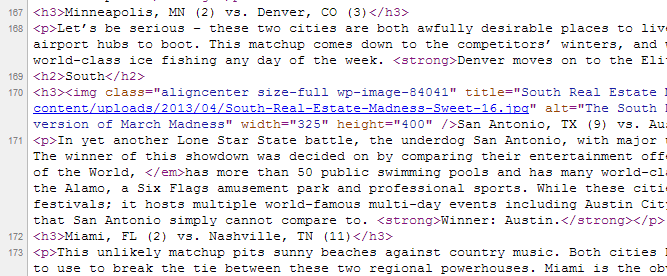You are viewing our site as an Agent, Switch Your View:
Agent | Broker Reset Filters to Default Back to ListSocial + SEO: Content Formatting
April 24 2013
 This is the first article of "Social + SEO," a series of monthly educational blog posts on social media and SEO tools and strategies that real estate agents can use to expand their business. Social + SEO will cover topics and strategies that are easy to learn, simple to implement and, most importantly, will provide you with an immediate return on your time investment.
This is the first article of "Social + SEO," a series of monthly educational blog posts on social media and SEO tools and strategies that real estate agents can use to expand their business. Social + SEO will cover topics and strategies that are easy to learn, simple to implement and, most importantly, will provide you with an immediate return on your time investment.
Every Social + SEO post will cover two topics, one on social media and another on search engine optimization. I will describe each topic, demonstrate how you can implement it and then explain how your business will benefit.
Review – What is Social Media and SEO?
Before we delve into this month's topics, I want to make sure that you know what I mean when I say "social media" and "search engine optimization."
Social media, simply put, are the ways people communicate with each other through the Internet. The best examples of social media include social networks like Twitter, Facebook and Google+, but other services, like YouTube, Instagram and even some video games can be put into that category as well.
Search engine optimization, or SEO, is the process of increasing the number of times a website, web page or blog post gets clicked in search engine results. This is primarily accomplished by improving the rankings of sites and pages in the search results of Google, Yahoo, Bing and other search engines.
Search engine rankings are determined by many different factors; the exact number varies based on the search engine. Google, for example, has more than 200 known factors that play into its search engine ranking process. These include the number and quality of links a piece of content receives, the number of times it is shared on social media, and the average amount of time visitors spend reading the content.
Content Formatting
Proper formatting of text on the Internet is critical because it impacts how both people and search engines view it. People are more likely to read a blog post that consists of multiple paragraphs, headers, lists and other formatting elements than a blog post that consists of just one paragraph – a massive, impenetrable block of text. Search engines recognize this, and, because their goal is to provide the best web content to their users, place well-formatted content higher in their result pages than similar content that is not formatted well.
It's important to note that simply having well-formatted text on your site won't make it rank on the first page of search engine results for every keyword you target. However, because properly formatting text is relatively simple to accomplish, it is arguably the most fundamental aspect of SEO and is something that everyone who publishes content on the web should implement.
Paragraphs
Your first formatting consideration when writing an article should be its paragraph structure. Paragraphs are the most fundamental way of organizing text; sentences that are all closely related are lumped together so that information is conveyed to the reader in an easy and logical manner. For example, the paragraph you are reading now is the introductory paragraph for this section; I will begin the second paragraph once it is time to discuss a new topic.
Many novice writers have the tendency to combine a multitude of topics into single paragraphs. As a result, their content features massive blocks of text that are difficult to penetrate. It can be confusing when you have many different topics present in the same place, and the sheer volume of words present in large paragraphs makes them hard to read.
Whenever you are writing a piece of content, always try to break large paragraphs down into several smaller ones. Roughly speaking, "large" paragraphs are those that are seven or more lines in length. Ideally, you will never have a paragraph that is longer than 10 lines.
Of course, being too eager to break up paragraphs can pose some danger.
Making paragraphs smaller than they should be deprives them of meaning.
For example, this paragraph and the two above it should be combined into a single paragraph.
Lists
Numbered (ordered) and bulleted (unordered) lists are my favorite ways to format content. This is because lists do the following:
- They convey large sets of information in a concise way.
- They can break down long sentences into short, easy-to-read chunks.
- They make it easy for readers to follow your line of thinking or the steps you took to accomplish something. This is particularly true for numbered lists.
Use the following steps to create lists:
- Find long paragraphs that cover many aspects of a similar subject. For example, paragraphs discussing the many steps you need to make in order to get a mortgage loan or descriptions of your city's neighborhoods.
- Identify the individual components of the overarching subject. For example, identify the sentences that pertain to each city neighborhood or step of the mortgage loan application process.
- Determine what kind of list is most appropriate to use. For example, a bulleted list would be best for descriptions of city neighborhoods, and a numbered list would be best for providing the steps required to get a mortgage loan.
- Break the long paragraph into many items on your numbered or bulleted list.
Headers
It is vital that you use headings and subheadings because they are used to organize content and communicate what individual sections are about in broad terms. A piece of content without headers is of poor quality, regardless of the information it contains and how that information is conveyed. The many subjects this post encompasses would make it impossible to read were it not for the many headers that organize it.
Headers are equally useful for search engines. Search engines use headers to understand what articles are about so they can give their users exactly what they are looking for. It is thus absolutely necessary to use headers – and, if possible, include keywords within them – so as to maximize your content's SEO potential.
It is not enough to make your headers bold. You must use special HTML code to identify headers for search engines. Use the following code snippets as examples for how headings look:

Here is some sample HTML code from a published blog post:

I will discuss putting keywords in headers in further detail in an upcoming blog post.
Bold, Italics and Underline
There is no better way to communicate to readers what words you are trying to emphasize or to show them what parts of your content is most important than to underline, italicize or bold them. These basic formatting techniques are most useful for human readers, but some search engine optimizers believe that putting your keywords in bold will help their content rank higher for those keywords in search engine results.
Please note that one of the biggest formatting mistakes you can make is to overuse bold, italicized or underlined text. It would be obnoxious and off-putting to read an entire article written in the same style I used for the first sentence of this section.
Horizontal Rules
A horizontal rule is an underutilized but effective formatting trick that is most useful for long pieces of content. When you need to communicate to the reader and search engines that you are switching from one broad, overarching topic to another, use a horizontal rule.
To make a horizontal rule, or "HR," simply type the following code snippet into your HTML editor:
I typically give some additional specifications on how the horizontal rule should appear (called HTML attributes), like height. This is the horizontal rule I use most frequently:
This code snippet creates a horizontal rule that is two pixels high.For those who want to be adventurous and change the appearance of their horizontal rules, use these simple HTML horizontal rule attributes.
How You Benefit
As I discussed above, formatting text will help both human readers and search engines access and understand your content more easily. This will encourage people to share your content and spend more time reading it, two of the important SEO factors discussed in the "Review" section of this blog post. Search engines place a premium on well-formatted content because they have a better understanding of what it is about and figure that human readers will appreciate it more than poorly-formatted content.
Having well-formatted text won't propel your content to the front page of Google's search engine results, but it is your first step to getting there.
To view the original article, visit the Market Leader blog.









